- Home
- Barbara Ehrenreich
Witches, Midwives, and Nurses Page 2
Witches, Midwives, and Nurses Read online
Page 2
Looking back after all these years, what strikes us about the witch hunts are not only the bizarre beliefs that inspired them and the personal tragedies that ensued, but the sheer waste of talent and knowledge that they represented. The victims, besides the individual women who were tortured and executed, were also all the people who were consequently deprived of their healing or midwifery skills. At a time we now associate with the Renaissance in Europe and the first signs of the scientific revolution, the witch hunts were a step back toward ignorance and helplessness—and not only for the largely lower-class people who lost so many of their traditional healers.
Instead, what could have been a proud occupation for women and a field for lively intellectual inquiry was discredited when not actually obliterated, so that later, when members of the educated elite sought to recapture some of the lost knowledge of the natural world, they had to turn to fairly marginal remnants of the old healing tradition. As Richard Holmes writes of the great English botanist Joseph Banks in the mid-eighteenth century, his interest in botany: “. . . brought him into contact with a race of people who would normally have been quite invisible to a privileged Eton schoolboy such as he. These were the wise women of the country lanes and hedgerows, the gypsy herbalists who collected “simples” or medicinal plants . . . They were a strange but knowledgeable tribe, whom he soon learned to treat with respect.”14
The suppression of the “witches” and the later, less violent elimination of midwives and aspiring female doctors in the United States are hardly the only instances in history of willfully squandered talent, education, and experience. Human intellectual progress proceeds, to the extent that it does at all, only haltingly, with ghastly interruptions for the slaughter of suspicious individuals or groups, colonial extirpations of indigenous cultures, and backslidings into religiously imposed ignorance. Sometimes an important task for progressives is the “conservative” one of recovering, or at least pointing out, what was lost.
We are immensely proud of the role this little booklet has played in women’s reclamation of healing roles in the late twentieth century—not all by itself of course, but along with the larger women’s movement and women’s health movement that it grew out of. It helped inspire young women to go to medical school, to recreate the profession of midwifery in America, and to advance the status of the nursing profession. We would underscore for new readers, however, that our concern was for class and racial equity as well as for women as a group. Compared to what we confronted in the 1970s, today’s American health care system features far more women as practitioners and even decision makers, but it is also more single-mindedly driven by profit. We are hopeful that Obama’s health reform will curb its murderous tendency to exclude those who most need care, but basic problems of access and affordability will remain. For all our gains, we clearly have our work cut out for us.
Barbara Ehrenreich
Deirdre English
March 2010
NOTES
1 John Demos, The Enemy Within: 2000 Years of Witch-Hunting in the Western World (New York: Viking, 2008), 38.
2 Andrew Wear, Lawrence I. Conrad, et al, The Western Medical Tradition 800 bc-1800, The Wellcome Institute for the History of Medicine (Cambridge: Cambridge University Press, 1995), 237.
3 Ibid., 233.
4 Ibid., 236.
5 Keith Thomas, Religion and the Decline of Magic: Studies in Popular Beliefs in Sixteenth and Seventeenth Century England (London: Weidenfeld and Nicolson, 1971), 14.
6 David Harley, “Historians as Demonologists: The Myth of the Midwife-Witch,” The Society for the Social History of Medicine (1990): 1-26.
7 Jane P. Davidson, “The Myth of the Persecuted Female Healer,” in The Witchcraft Reader, 2nd edition, ed. Darren Oldridge (New York: Routledge, 2008), 257.
8 Henricus Institoris, O.P. and Jacobus Sprenger, O.P., The Malleus Maleficarum, vol II, trans. and ed. Christopher S. Mac-Kay (Cambridge: Cambridge University Press, 2006), 164.
9 Lyndal Roper, Witch Craze (New Haven and London: Yale University Press, 2004) 70, 33, 187.
10 Brian P. Levack, The Witch-Hunt in Early Modern Europe, Third Edition (Harlow, England: Pearson Longman, 1995), 146, 127.
11 William Perkins, “The Damned Art of Witchcraft,” excerpted in The Witchcraft Sourcebook by Brian P. Levack (New York: Routledge, 2004), 94-6.
12 David D. Hall, Witch Hunting in Seventeenth Century New England: A Documentary History 1638-1693 (Boston: North-eastern University Press, 1991), 5.
13 Demos, The Enemy Within, 119, 43.
14 Richard Holmes, The Age of Wonder: How the Romantic Generation Discovered the Beauty and Terror of Science (New York: Pantheon, 2008), 7.
Introduction to the First Edition
WOMEN HAVE ALWAYS BEEN HEALERS. THEY WERE THE unlicensed doctors and anatomists of Western history. They were abortionists, nurses, and counselors. They were pharmacists, cultivating healing herbs and exchanging secrets of their uses. They were midwives, travelling from home to home and village to village. For centuries women were doctors without degrees, barred from books and lectures, learning from each other, and passing on experience from neighbor to neighbor and mother to daughter. They were called “wise women” by the people, witches or charlatans by the authorities. Medicine is part of our heritage as women, our history, our birthright.
Today, however, health care is the property of male professionals. Ninety-three percent of the doctors in the US are men, as are almost all the top directors and administrators of health institutions. Women are still in the overall majority—70 percent of health workers are women—but we have been incorporated as workers into an industry where the bosses are men. We are no longer independent practitioners, known by our own names, for our own work. We are, for the most part, institutional fixtures filling faceless job slots: clerk, dietary aide, technician, maid.
When we are allowed to participate in the healing process, we can do so only as nurses. And nurses of every rank from aide up are just “ancillary workers” in relation to the doctors (from the Latin ancilla, maid servant). From the nurses’ aide, whose menial tasks are spelled out with industrial precision, to the “professional” nurse, who translates the doctors’ orders into the aide’s tasks, nurses share the status of a uniformed maid service to the dominant male professionals.
Our subservience is reinforced by our ignorance, and our ignorance is enforced. Nurses are taught not to question, not to challenge. “The doctor knows best.” He is the shaman, in touch with the forbidden, mystically complex world of Science which we have been taught is beyond our grasp. Women health workers are alienated from the scientific substance of their work, restricted to the “womanly” business of nurturing and housekeeping—a passive, silent majority.
We are told that our subservience is biologically ordained: women are inherently nurse-like and not doctor-like. Sometimes we even try to console ourselves with the theory that we were defeated by anatomy before we were defeated by men, that women have been so trapped by the cycles of menstruation and reproduction that they have never been free and creative agents outside their homes. Another myth, fostered by conventional medical histories, is that male professionals won out on the strength of their superior technology. According to these accounts, (male) science more or less automatically replaced (female) superstition—which from then on was called “old wives’ tales.”
But history belies these theories. Women have been autonomous healers, often the only healers for women and the poor. And we found, in the periods we have studied, that, if anything, it was the male professionals who clung to untested doctrines and ritualistic practices—and it was the women healers who represented a more human, empirical approach to healing.
Our position in the health system today is not “natural.” It is a condition which has to be explained. In this pamphlet we have asked: How did we arrive at our present position of subservience from our former position of leadership?
We learned this much: t
he suppression of women health workers and the rise to dominance of male professionals was not a “natural” process, resulting automatically from changes in medical science, nor was it the result of women’s failure to take on healing work. It was an active takeover by male professionals. And it was not science that enabled men to win out: the critical battles took place long before the development of modern scientific technology.
The stakes of the struggle were high: political and economic monopolization of medicine meant control over its institutional organizations, its theory and practice, its profits and prestige. And the stakes are even higher today, when total control of medicine means potential power to determine who will live and who will die, who is fertile and who is sterile, who is “mad” and who is sane.
The suppression of female healers by the medical establishment was a political struggle, first, in that it is part of the history of sex struggle in general. The status of women healers has risen and fallen with the status of women. When women healers were attacked, they were attacked as women; when they fought back, they fought back in solidarity with all women.
It was a political struggle, second, in that it was part of a class struggle. Women healers were people’s doctors, and their medicine was part of a people’s subculture. To this very day women’s medical practices have thrived in the midst of rebellious lower-class movements which have struggled to be free from the established authorities. Male professionals, on the other hand, served the ruling class—both medically and politically. Their interests have been advanced by the universities, the philanthropic foundations, and the law. They owe their victory—not so much to their own efforts—but to the intervention of the ruling class they served.
This pamphlet represents a beginning of the research which will have to be done to recapture our history as health workers. It is a fragmentary account, assembled from sources that were usually sketchy and often biased, by women who are in no sense “professional” historians. We confined ourselves to Western history, since the institutions we confront today are the products of Western civilization. We are far from being able to present a complete chronological history. Instead, we looked at two separate, important phases in the male takeover of health care: the suppression of witches in medieval Europe, and the rise of the male medical profession in nineteenth century America.
To know our history is to begin to see how to take up the struggle again.
Witchcraft and Medicine in the Middle Ages
WITCHES LIVED AND WERE BURNED LONG BEFORE the development of modern medical technology. The great majority of them were lay healers serving the peasant population, and their suppression marks one of the opening struggles in the history of man’s suppression of women as healers.
The other side of the suppression of witches as healers was the creation of a new male medical profession, under the protection and patronage of the ruling classes. This new European medical profession played an important role in the witch hunts, supporting the witches’ persecutors with “medical” reasoning:. . . Because the Medieval Church, with the support of kings, princes and secular authorities, controlled medical education and practice, the Inquisition [witch hunts] constitutes, among other things, an early instance of the “professional” repudiating the skills and interfering with the rights of the “nonprofessional” to minister to the poor. (Thomas Szasz, The Manufacture of Madness)
The witch hunts left a lasting effect: an aspect of the female has ever since been associated with the witch, and an aura of contamination has remained—especially around the midwife and other women healers. This early and devastating exclusion of women from independent healing roles was a violent precedent and a warning: it was to become a theme of our history. The women’s health movement of today has ancient roots in the medieval covens, and its opponents have as their ancestors those who ruthlessly forced the elimination of witches.
Witch healing peasants (Breughel)
THE WITCH CRAZE
The age of witch hunting spanned more than four centuries (from the fourteenth to the seventeenth century) in its sweep from Germany to England. It was born in feudalism and lasted—gaining in virulence—well into the “age of reason.” The witch craze took different forms at different times and place, but never lost its essential character: that of a ruling class campaign of terror directed against the female peasant population. Witches represented a political, religious, and sexual threat to the Protestant and Catholic churches alike, as well as to the State.
The extent of the witch craze is startling: In the late fifteenth and early sixteenth centuries there were thousands upon thousands of executions—usually live burnings at the stake—in Germany, Italy, and other countries. In the mid-sixteenth century the terror spread to France, and finally to England. One writer has estimated the number of executions on an average of 600 a year for certain German cities—or two a day, “leaving out Sundays.” Nine hundred witches were destroyed in a single year in the Wertzberg area, and 1000 in and around Como. At Toulouse, four hundred were put to death in a day. In the Bishopric of Trier, in 1585, two villages were left with only one female inhabitant each. Many writers have estimated the total number killed to have been in the millions. Women made up some 85 percent of those executed—old women, young women, and children.a
Their scope alone suggests that the witch hunts represent a deep-seated social phenomenon which goes far beyond the history of medicine. In locale and timing, the most virulent witch hunts were associated with periods of great social upheaval shaking feudalism at its roots—mass peasant uprisings and conspiracies, the beginnings of capitalism, and the rise of Protestantism. There is fragmentary evidence—which feminists ought to follow up suggesting that in some areas witchcraft represented a female-led peasant rebellion. Here we can’t attempt to explore the historical context of the witch hunts in any depth. But we do have to get beyond some common myths about the witch craze—myths that rob the “witch” of any dignity and put the blame on her and the peasants she served.
Unfortunately, the witch herself—poor and illiterate—did not leave us her story. It was recorded, like all history, by the educated elite, so that today we know the witch only through the eyes of her persecutors.
Two of the most common theories of the witch hunts are basically medical interpretations, attributing the witch craze to unexplainable outbreaks of mass hysteria. One version has it that the peasantry went mad. According to this, the witch craze was an epidemic of mass hatred and panic cast in images of a blood-lusty peasant mob bearing flaming torches. Another psychiatric interpretation holds that the witches themselves were insane. One authoritative psychiatric historian, Gregory Zilboorg, wrote that:. . . millions of witches, sorcerers, possessed and obsessed were an enormous mass of severe neurotics [and] psychotics . . . for many years the world looked like veritable insane asylum . . .
But, in fact, the witch craze was neither a lynching party nor a mass suicide by hysterical women. Rather, it followed well-ordered, legalistic procedures. The witch hunts were well-organized campaigns, initiated, financed, and executed by Church and State. To Catholic and Protestant witch hunters alike, the unquestioned authority on how to conduct a witch hunt was The Malleus Maleficarum, or Hammer of Witches, written in 1484 by the Reverends Kramer and Sprenger (the “beloved sons” of Pope Innocent VIII.) For three centuries this sadistic book lay on the bench of every judge, every witch hunter. In a long section on judicial proceedings, the instructions make it clear how the “hysteria” was set off: the job of initiating a witch trial was to be performed by either the Vicar (priest) or Judge of the County, who was to post a notice todirect, command, require and admonish that within the space of twelve days . . . that they should reveal it unto us if anyone know, see or have heard that any person is reported to be a heretic or a witch, or if any is suspected especially of such practices as cause injury to men, cattle, or the fruits of the earth, to the loss of the State.
Three witches hanging, from the title page o
f a contemporary pamphlet on the third Chelmsford witch trial, 1589
Anyone failing to report a witch faced both excommunication and a long list of temporal punishments.
If this threatening notice exposed at least one witch, her trial could be used to unearth several more. Kramer and Sprenger gave detailed instructions about the use of torture to force confessions and further accusations. Commonly, the accused was stripped naked and shaved of all her body hair, then subjected to thumbscrews and the rack, spikes and bone-crushing “boots,” starvation and beatings. The point is obvious: the witch craze did not arise spontaneously in the peasantry. It was a calculated ruling class campaign of terrorization.
THE CRIMES OF WITCHES
Who were the witches, then, and what were their “crimes” that could arouse such vicious upper-class suppression? Undoubtedly, over the centuries of witch hunting, the charge of “witchcraft” came to cover a multitude of sins ranging from political subversion and religious heresy to lewdness and blasphemy. But three central accusations emerge repeatedly in the history of witchcraft throughout northern Europe: First, witches are accused of every conceivable sexual crime against men. Quite simply, they are “accused” of female sexuality. Second, they are accused of being organized. Third, they are accused of having magical powers effecting health—of harming, but also of healing. They were often charged specifically with possessing medical and obstetrical skills.

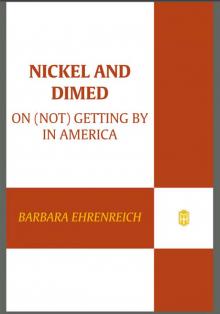 Nickel and Dimed: On (Not) Getting by in America
Nickel and Dimed: On (Not) Getting by in America Living With a Wild God
Living With a Wild God Bright-Sided
Bright-Sided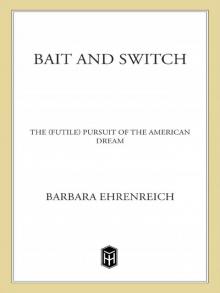 Bait and Switch: The (Futile) Pursuit of the American Dream
Bait and Switch: The (Futile) Pursuit of the American Dream Dancing in the Streets: A History of Collective Joy
Dancing in the Streets: A History of Collective Joy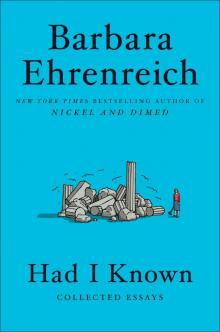 Had I Known
Had I Known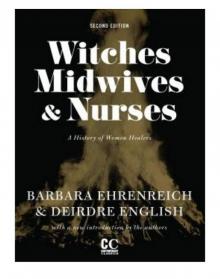 Witches, Midwives, and Nurses
Witches, Midwives, and Nurses For Her Own Good: Two Centuries of the Experts Advice to Women
For Her Own Good: Two Centuries of the Experts Advice to Women Nickel and Dimed
Nickel and Dimed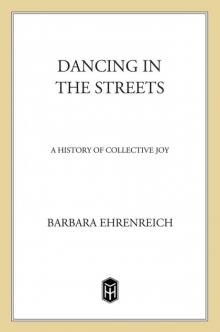 Dancing in the Streets
Dancing in the Streets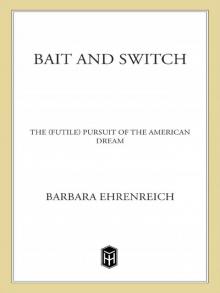 Bait and Switch
Bait and Switch